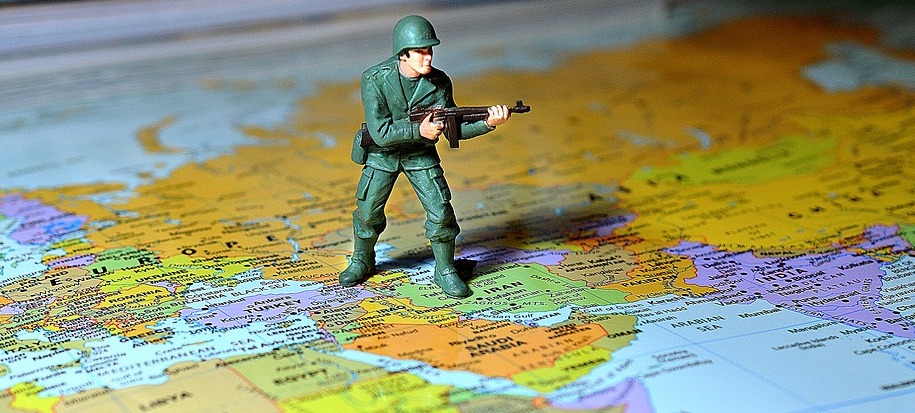Future of Security-Middle East
September 26, 2019 | Expert Insights
The Impact of History- The Generational Syndrome
Generational Syndrome has deeply influenced the political history of the Middle East in the last 100 years. Taking the end of WW 2 as a start point, every 30 years, a cataclysmic change has come over the political landscape. As the younger generation replaced the earlier one, it discarded the legacy political culture, sometimes violently, in favour of a new social and political agenda.
Up to the 1960s, there was a proclivity to adopt western-inspired democratic principles. Egypt and Iraq under the British Mandate and Syria and Lebanon under French sphere of influence reflected the political ideas of their colonisers. Within the next decade, most Middle Eastern political systems had been tailored to adapt to the western democratic model.
Thirty years later, in the 1950s, as communism under USSR became the flavour of the day, the current generation of rulers in the Middle East were attracted towards it. It all began with the Young Officers coup in Egypt in 1952 and rapidly spread to Syria, Libya, Yemen and finally Iraq. In time, all these countries deepened their strategic bonds with “mother” Soviet Union. The cold war was at its peak and the major Arab countries stood shoulder to shoulder with the USSR against the West. Israel was isolated as the American agent in the region.
Another three decades later, the transformation re-occurred. This time around it was the Islamic revolution which exploded like a dormant volcano in Iran. The Iranian revolution inspired the birth of a host of Islamic parties which mushroomed all over the Middle East. This new generation, infused with religious fervour, is exemplified by the Muslim Brotherhood who grabbed the limelight when they engineered the assassination of President Assad in 1981. One year later Assad’s regime in Syria had to confront an Islamic mutiny. Hezbollah came into being in Lebanon along with the Hamas faction in Palestine during the same period.
Fast forward thirty years to 2010 and the generational change saw Arab Spring which erupted in Tunisia and spread like wildfire over Egypt, Syria, Libya and Yemen. The “Spring” was a resounding call for social changes in a society which had remained feudal in character despite the trappings of socialism. It arose from the ruins of Arab socialism and was nourished by the excesses of repressive regimes like Alawite Assad of Syria and Sunni Saddam of Iraq, ruling over a suppressed majority.
But the absence of efficient political structures in these countries failed to direct the energy of the Arab Spring into positive political alignments. These were subsumed by the ethnoreligious bigotry which we see so predominantly displayed today.
The short-lived take-over by Mouhamd Moursi in Egypt on behalf of the “Muslim Brotherhood”, the wars in Yemen, Libya and the ongoing ethnic tension in Syria, Iraq and Lebanon together manifest the fact that today in the main, the political rift in the region is much less driven by a social motivation and more by politico-ethnic interests.
Middle East Today
If we study the last 5-7 years of turmoil in major Arab countries, we can conclude that the conflict is being waged at three distinct levels, making the region more divided than it ever was.
At the politico-religious level, the struggle is between the Shites and the Sunnis with Iran the doyen of the Shiite camp and ranged against it are the ultra-conservative Sunni Islamic regimes led by Saudi Arabia.
Next is the ethnic level which is witnessing several minor wars stretching from Libya in the West, through Yemen in the South to Syria in the North. In addition, there is the consistent tension between an assortment of ethnic groups making up Lebanon and Iraq.
Last but not least, the international dimension continues to make the middle east lucrative for international players to play the Great Game. US (despite Trump’s call for “ let’s put America first”) and Putin’s Russia in its new aggressive form are at the forefront along with their traditional allies and hangers-on. Putin has emerged as a major player in the region. He has actually driven the outcome of the Syrian civil war by dispatching military forces which fought alongside the Iranian/Hizballah troops against the Syrian opposition. This has altered the balance of power in the Middle East leaving the entire region open to much greater Russian influence.
The Future
The Middle East remains a flashpoint with several active civil wars, a hub for Islamic extremism, and aspiring nuclear powers lurking in the shadows. The future can be summed up in five pertinent questions.
Do we need a new Sykes-Picot Plan which takes into consideration the ethnic makeup of the region and re-draws frontiers as was done in the Balkans at the beginning of the millennium?
Will the Middle East be the origin for the next world war? A military confrontation between Iran and Saudi Arabia or Israel and Iran has the potential to rapidly spiral out of control and take the shape of a global conflagration.
Will there be popular revolts against the autocratic regimes leading to greater instability? Arabic kingdoms and conservative states like Egypt, Libya and Yemen are seething with discontent and are ripe for popular uprisings. A greater instability could easily endanger global interests and jeopardise oil supplies and freedom of navigation in the Persian Gulf and Suez Canal.
Will Terror rise again like the phoenix from ashes of the Islamic Caliphate of ISIS? The spores are very much alive, although dormant for the time being.
Will the Middle East become a Nuclear Battlefield. Iran, Egypt and Turkey are all potential nuclear powers. If Iran was to cross the nuclear Rubicon, Egypt, Turkey and perhaps Saudi Arabia (With Pakistani nukes), are likely to quickly follow suit. This would be a nuclear nightmare too terrifying to behold.



Comments